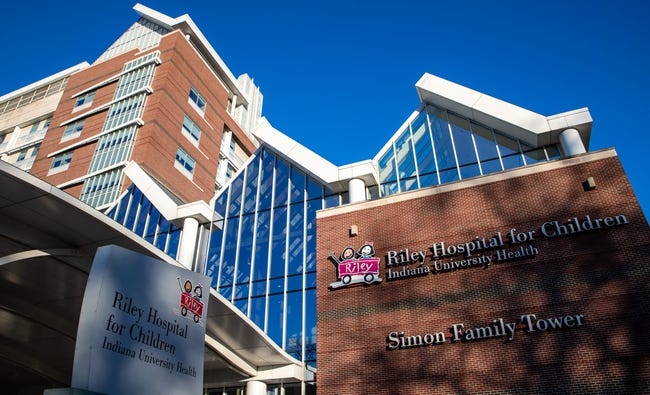Riley Hospital for Children is the centerpiece of Riley Children’s Health, a pediatric healthcare system that has grown to serve the State of Indiana and beyond.

The hospital began when prominent friends formed the Memorial Committee to honor the memory of the widely known and recognized Hoosier poet, beloved for his poetry celebrating children. While the Committee forwarded several ideas for commemorating his life, Dr. Lafayette Page, a member of the faculty, proposed the winning idea of building a children’s hospital. In 1917, on the eve of U.S. entry into World War I, the Memorial Committee announced its support for constructing such a pediatric facility. The war interrupted this initiative.
After World War I, the Committee resumed work and in 1921 joined with Indiana University and the Indiana Children’s Welfare Association to secure passage of legislation providing state funds to build and support the hospital. The Memorial Committee incorporated as the James Whitcomb Riley Memorial Association (now known as the ) and established the Joint Executive Committee, which included members from both the Association and Indiana University. This Joint Executive Committee jointly supervised the planning, building, and initial operating of the hospital. The James Whitcomb Riley Hospital for Children, dedicated on the anniversary of Riley’s birthday, October 7, 1924, began treating patients on November 19, 1924.
Early expansion efforts included the 1930 “K” Wing for treatment of orthopedic patients and the mid-1950s Kiwanis Diagnostic and Outpatient Center, both funded by Indiana District of , and the 1931 Rotary Convalescent Center funded by Rotary Clubs of Indiana. The hospital’s hydrotherapeutic pool designed to help patients with polio was one of President Franklin Delano Roosevelt’s stops during a 1936 Indianapolis visit.
Enriched since 1924 by an Indiana University School of Medicine affiliation, Riley Children’s Health’s many “firsts” for the State of Indiana and nation for pediatric medical procedures include: first in the nation to carry out percutaneous cardiac catheterization in children (early 1950s). The hospital was the first in Indiana to use echocardiography (1966), to insert a cochlear implant in a deaf child’s ear (1983), child liver transplant (1988), heart and lung transplants in newborns (1989), pediatric cord blood transplant (1994), and intestinal and multi-organ transplants in children (2003). “First” pediatric healthcare services and programs for Indiana include: pediatric burn care unit and neonatal intensive care unit (1971), outpatient surgical care and pediatric stem cell transplant unit (1994).
Several construction phases, much supported by charitable donations, expanded the hospital: 1965—surgery wing; 1971—hospital completed Phase II, its first major expansion, seeded by a Baxter Foundation gift; 1986 – Riley Hospital inpatient building (Phase III, 250,000 sq. ft.); 2000 – Riley Hospital Outpatient Center (Phase IV); 2013 – The Simon Family Tower, a 10-story, 675,000 square foot in-patient tower opened in 2011 with all phases completed by 2013. The Riley Maternity Health Tower opened in September 2021. The facility forms the IU Health’s “downtown hub for childbirth and newborn care” and replaced those that had been housed at .
In 1997, the hospital joined the Clarian Health system; in 2011, Clarian Health hospitals aligned under a new name, indiana university health; in 2016, Riley Hospital for Children at IU Health became Riley Children’s Health to better reflect the statewide and community outreach of Riley-affiliated medical professionals and network of pediatric services.

Help improve this entry
Contribute information, offer corrections, suggest images.
You can also recommend new entries related to this topic.

